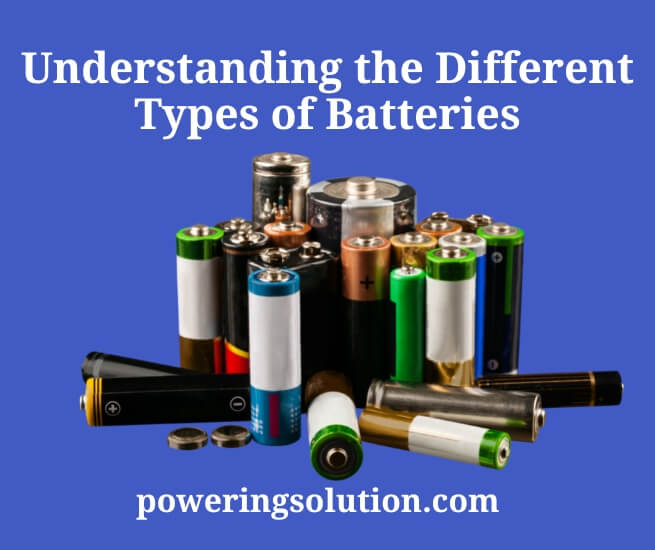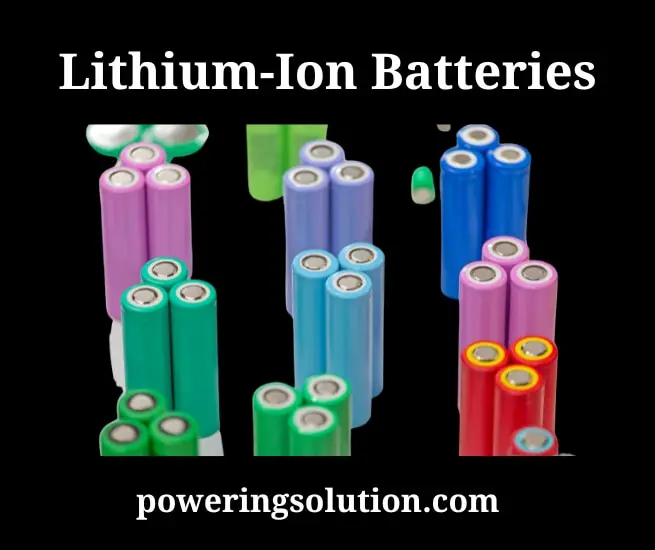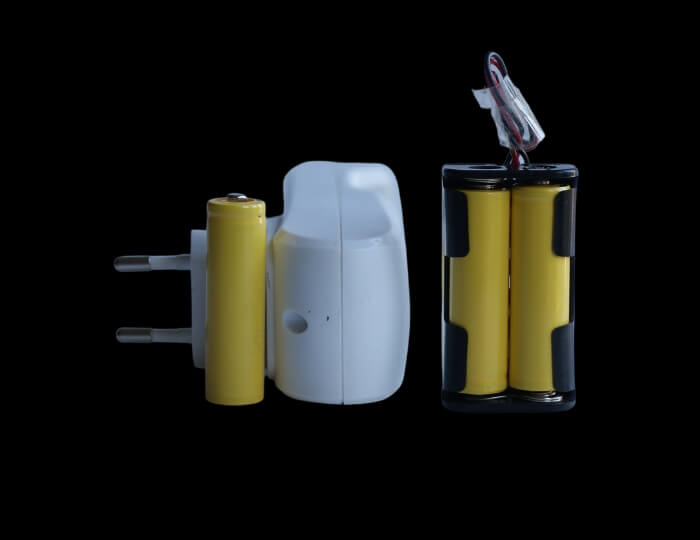Batteries are an essential component in our daily lives, providing power to a wide range of devices such as smartphones, laptops, cars, and even medical equipment. They come in various shapes, sizes, and capacities and are classified into different types based on the technology used in their construction.

Some of the most common types of batteries include alkaline batteries, lithium-ion batteries, nickel-cadmium batteries, nickel-metal Hydride batteries, and lead-acid batteries, each with its own unique set of advantages and disadvantages. In this overview, we’ll take a closer look at the different types of batteries and the specific applications they are best suited for.
Primary Batteries
Primary batteries, also known as disposable batteries, are a type of battery that is designed to be used once and then discarded. They are non-rechargeable and rely on a chemical reaction within the battery to produce an electrical charge. Once the reaction is depleted, the battery can no longer produce a charge and must be replaced.
Primary batteries are commonly used in low-drain devices such as flashlights, remote controls, and toys, and are a convenient source of power for devices that are used infrequently or are not connected to a power source. Despite their convenience, primary batteries are not environmentally friendly and can be expensive over time, so it is important to choose the right type of battery for the specific application.
Here are some common examples of primary batteries:
Alkaline Batteries
Alkaline batteries are a type of non-rechargeable battery that is widely used in household items like flashlights, toys, and remote controls. They are known for their long shelf life and consistent performance over time.
Uses
Alkaline batteries are commonly used in low-drain devices that don’t require a lot of power, such as remote controls and flashlights.
Advantages
Alkaline batteries are long-lasting and have a stable voltage output, making them a popular choice for devices that require consistent power. They are also widely available and relatively cheap compared to other types of batteries.
Disadvantages
The main disadvantage of alkaline batteries is that they are not rechargeable, so they must be disposed of and replaced when they run out of power. Additionally, they can leak and cause damage to the devices they power if they are left unused for an extended period.
Lithium-Ion Batteries
Lithium-ion batteries are a type of rechargeable battery that has become increasingly popular in recent years. They are widely used in consumer electronics, such as laptops, smartphones, and digital cameras.
Uses
Lithium-ion batteries are used in high-drain devices that require a lot of power, such as laptops and smartphones.
Advantages
Lithium-ion batteries have a high energy density, meaning they can store a lot of energy in a small package. They also have a low self-discharge rate, meaning they can retain a charge for a long time. Additionally, they are rechargeable, which makes them more environmentally friendly than disposable alkaline batteries.
Disadvantages
Lithium-ion batteries can be expensive compared to other types of batteries. They can also be hazardous if they are damaged or abused, as they can catch fire or explode.
Nickel-Cadmium Batteries
Nickel-cadmium (NiCad) batteries are a type of rechargeable battery that has been used for many years. They are widely used in industrial and commercial applications, such as power tools and electric vehicles.
Uses
Nickel-cadmium batteries are used in high-drain devices that require a lot of power, such as power tools and electric vehicles.
Advantages
Nickel-cadmium batteries have a long life cycle, meaning they can be recharged and used many times before they need to be replaced. They are also relatively cheap compared to other types of batteries.
Disadvantages
Nickel-cadmium batteries have a “memory effect,” meaning they can lose their ability to fully charge if they are not fully discharged before being recharged. They can also be hazardous if they are damaged or abused, as they contain toxic metals that can leak and cause environmental damage.
Secondary Batteries
Secondary batteries, also known as rechargeable batteries, are a type of battery that can be recharged and used multiple times before they need to be replaced. They are different from primary batteries, which are designed to be used once and then disposed of. Secondary batteries are becoming increasingly popular due to their cost-effectiveness and environmentally friendly nature.
Types of Secondary Batteries
Lithium-Ion Batteries

Lithium-ion batteries are a type of rechargeable battery that has become increasingly popular in recent years. They are widely used in consumer electronics, such as laptops, smartphones, and digital cameras. Lithium-ion batteries are known for their high energy density, long shelf life, and low self-discharge rate, making them an ideal choice for a variety of applications.
Nickel-Cadmium Batteries
Nickel-cadmium (NiCad) batteries are a type of rechargeable battery that has been used for many years. They are widely used in industrial and commercial applications, such as power tools and electric vehicles. NiCad batteries are known for their reliability and long service life, making them an ideal choice for applications that require frequent and intense use.
Nickel Metal Hydride Batteries
Nickel metal hydride (NiMH) batteries are a type of rechargeable battery that has become increasingly popular in recent years. They are commonly used in consumer electronics, such as digital cameras and portable power banks. NiMH batteries have a higher energy density than NiCad batteries and are also environmentally friendly, as they do not contain cadmium, a toxic metal.
Lead-Acid Batteries
Lead-acid batteries are a type of rechargeable battery that has been used for many years. They are widely used in automobiles, backup power systems, and other applications that require a lot of power. Lead-acid batteries are relatively low cost and have a long service life, making them an ideal choice for applications that require a large amount of power.
Advantages of Secondary Batteries
Cost-Effective
Secondary batteries are more cost-effective in the long run compared to primary batteries, as they can be recharged and used multiple times before they need to be replaced. This can result in significant savings over time, especially for applications that require a lot of power.
Environmentally Friendly
Secondary batteries are more environmentally friendly than primary batteries, as they can be reused many times before they need to be recycled or disposed of. This reduces the amount of waste generated by batteries and helps to conserve natural resources.
Convenient
Secondary batteries are more convenient than primary batteries, as they can be recharged whenever they run out of power, eliminating the need to constantly purchase and dispose of batteries. This makes them an ideal choice for applications that require a lot of power, such as backup power systems and portable devices.
Disadvantages of Secondary Batteries
Initial Cost
Secondary batteries are often more expensive than primary batteries, especially when purchased in bulk. This can be a significant drawback for some applications, especially for those that require a large number of batteries.
Charging Time
Secondary batteries can lose their ability to hold a charge over time, reducing their performance and requiring them to be replaced sooner. This can be a drawback for applications that require a long-lasting and reliable source of power.
So, we can say that Secondary batteries are essential for many modern technologies and play a crucial role in the development of renewable energy systems, such as electric vehicles and grid-scale energy storage. However, it is important to handle and dispose of secondary batteries properly, as they contain toxic and flammable materials that can be harmful to the environment and human health if not handled safely.
Rechargeable Batteries

Rechargeable batteries are a type of battery that can be recharged and used multiple times before they need to be replaced. They are becoming increasingly popular as people look for more environmentally friendly and cost-effective solutions to their power needs.
Types of Rechargeable Batteries
Lithium-Ion Batteries
Lithium-ion batteries are a type of rechargeable battery that has become increasingly popular in recent years. They are widely used in consumer electronics, such as laptops, smartphones, and digital cameras.
Nickel-Cadmium Batteries
Nickel-cadmium (NiCad) batteries are a type of rechargeable battery that has been used for many years. They are widely used in industrial and commercial applications, such as power tools and electric vehicles.
Nickel Metal Hydride Batteries
Nickel metal hydride (NiMH) batteries are a type of rechargeable battery that has become increasingly popular in recent years. They are commonly used in consumer electronics, such as digital cameras and portable power banks.
Lead-Acid Batteries
Lead-acid batteries are a type of rechargeable battery that has been used for many years. They are widely used in automobiles, backup power systems, and other applications that require a lot of power.
Advantages of Rechargeable Batteries
Cost-Effective
Rechargeable batteries are more cost-effective in the long run compared to disposable batteries, as they can be recharged and used multiple times before they need to be replaced.
Environmentally Friendly
Rechargeable batteries are more environmentally friendly than disposable batteries, as they can be reused many times before they need to be recycled or disposed of.
Convenient
Rechargeable batteries are more convenient, as they can be recharged whenever they run out of power, eliminating the need to constantly purchase and dispose of disposable batteries.
Disadvantages of Rechargeable Batteries
Initial Cost
Rechargeable batteries are often more expensive than disposable batteries, especially when purchased in bulk.
Charging Time
Rechargeable batteries often take longer to charge than disposable batteries, and some require special charging equipment.
Reduced Performance
Rechargeable batteries can lose their ability to hold a charge over time, reducing their performance and requiring them to be replaced sooner.
Rechargeable batteries are a cost-effective, environmentally friendly, and convenient alternative to disposable batteries. However, they do have some disadvantages, such as a higher initial cost and longer charging time, that must be considered before making a purchase.
Final Words
In conclusion, batteries play a crucial role in our daily lives, powering a wide range of devices and devices. Understanding the different types of batteries, including primary batteries and secondary batteries, is important in order to choose the right battery for your specific needs. Primary batteries are designed to be used once and then disposed of, while secondary batteries can be recharged and used multiple times.
Each type of battery has its own unique advantages and disadvantages, including cost, performance, and environmental impact. When choosing a battery, it is important to consider your specific needs and the requirements of your application, in order to select the best type of battery for your needs. Whether you need a reliable source of power for your flashlight, a long-lasting battery for your laptop, or a safe and environmentally friendly battery for your electric car, there is a type of battery available that will meet your needs.
